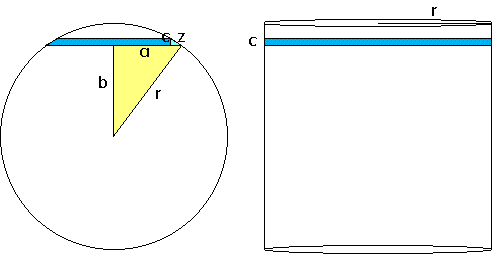
 |
Solids of revolution |
| First and Second Year of Secondary School | |
|
A Curiosity. |
||
|
A spherical zone is a spherical surface included between two parallel planes. |
||
|
There are
a sphere and a cylinder in the window. Both have the same radius and the
cylinder height is the same as the diameter.
In order
to prove it, we are going to look at a very narrow strip. |
||
 |
The
light blue right-angled triangle is similar to the yellow one because
their hypotenuse
are respectively perpendicular and their edges likewise. Their angles
are equal and their sides are proportional.
Consider
the ratio hypotenuse
/small edge
r/a = z/c Product
of the middle terms = product of the outer terms
a · z = r · c To find out the surface of
a narrow strip, you only have to multiply the circumference by the width.
The
spherical surface area of the strip
= 2 · π
· a · z
The
cylinder lateral surface area of the strip
= 2 · π · r · c With
this information, deduce the formula of the spherical zone surface area
knowing
the sphere radius and the separation distance of the planes.
|
|
| Eduardo Barbero Corral | ||
 |
||
| Spanish Ministry of Education. Year 2007 | ||

Except where otherwise noted, this work is licensed under a Creative Common License